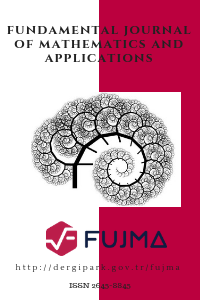Fluid Flow Characteristics for a Diverging-Converging Magnetohydrodynamic Electric Current Configuration
Fluid Flow Characteristics for a Diverging-Converging Magnetohydrodynamic Electric Current Configuration
Coupled and nonlinear equations, Electromagnetic pressure number, Finite difference, Magnetic pressure number, Reynolds number Secondary flows,
___
- [1] C. Y. Chow, M. S. Uberoi, Secondary flows due to axisymmetric converging-diverging electric current, Comput. Fluids, 6(2) (1978), 115-123.
- [2] M. S. Uberoi, Magnetohyerodynamics at small magnetic Reynolds numbers, Phys. Fluids, 5(4) (1962), 401-406.
- [3] J. P. Narain, M. S. Uberoi, Magnetohydroynamics of conical flows, Phys. Fluids, 14(12) (1971), 2687-2692.
- [4] J. A. Shercliff, The flow of conducting fluids in circular pipes under transverse magnetic fields J. Fluid Mech., 1(6) (1956), 644-666.
- [5] I. Di Piazza, A. Buhler, A general computational approach for magnetohydrodynmic flows using CFX code: buoyant flow though through a vertical square channel, Fusion Technol., 38(2) (2000), 180-189.
- [6] M. S. Uberoi, C. Y. Chow, Large scale motions in electrical discharges, Phys. Fluid, 20(11) (1977), 1815-1820.
- [7] J. M.Ritter, Two phase fluid flows in pipes and channels. MSc. Thesis, Tennessee Technological Society, 1976.
- [8] A. J. Chamkha, Unsteady laminar hydromagnetic fluid-particle flow and heat transfer in channels and circular pipes, Int. J. Heat Fluid Flow, 21(6) (2000), 740-746.
- [9] A. J. Chamkha, Hydromagnetic two-phase flow in a channel, Int. J. Engnr. Sci., 33(3) (1995), 437-446.
- [10] A. J. Chamkha, Time dependent two-phase channel flow due to an oscillating pressure gradient, Fluid Part. Sep. J., 8 (1995b), 203.
- [11] O. O. Onyejekwe, Magnetohydrodynamics flow in a tube with centrally placed electrodes, Int. Comm. Heat Mass Trans., 35(10) (2008), 1241-1245.
- [12] A. Pantokratoras, Some new parallel flows in weakly conducting fluids with an exponenetially decaying Lorentz force, Math. Probl. in Engnr., 2 (2007), Article ID 87814, 14 pages.
- [13] H. S. Kabbani, J. M. Martin, S. W. Joo, S. Qian, Analytical prediction of flow in magnetohydrodynamic fluidic devices, 130(9) (2008), 912041-912046.
- [14] V. M.Soundalgekar, Finite difference analysis of transient free convection with mass transfer on an isothermal vertical flat plate, Int. J. Engnr. Sci., 19(6) (1981), 757-770.
- [15] C. Y. Chow, An Introduction to Computational Fluid Mechanics, Publishers: John Wiley and Sons, 1979, 396 pages.
- [16] A. Altinas, I. Ozkol Magnetohydrodynamic flow of liquid-metal in circular pipes for externally heated non heated cases, J. Appl. Fluid Mech., 8(3) (2015), 507-514.
- [17] Z. Jing, M. J. Ni, Z. H. Wang, Numerical study of MHD natural convection of liquid metal with wall effects, Num. Heat Trans., 64(8) (2013), 676-693.
- [18] J. A. Rao, R. S. Raju, S. Sivsiah, Finite element solution of heat and mass transfer in MHD flow of a viscous fluid past a vertical plate under oscillatory suction velocity, J. Appl. Fluid Mech., 5(3) (2012), 1-10.
- ISSN: 2645-8845
- Yayın Aralığı: Yılda 4 Sayı
- Başlangıç: 2018
- Yayıncı: Fuat USTA
On Semi-Invariant Submanifolds of Trans-Sasakian Finsler Manifolds
Ayşe Funda SAĞLAMER, Nesrin ÇALIŞKAN
$\alpha_\kappa-$Implicit Contraction in non-AMMS with Some Applications
Ekber GİRGİN, Mahpeyker ÖZTÜRK
$\mathcal{I}$-Cesaro Summability of a Sequence of Order $\alpha$ of Random Variables in Probability
Qualitative Behavior of Two Rational Difference Equations
Mohammed ALMATRAFİ, E. M. ELSAYED, Faris ALZAHRANİ
Ahmed A. KHAMMASH, Marwa M. HAMED
Djourdem HABİB, Slimane BENAİCHA, Noureddine BOUTERAA
Explicit Solutions of a Class of (3+1)-Dimensional Nonlinear Model
